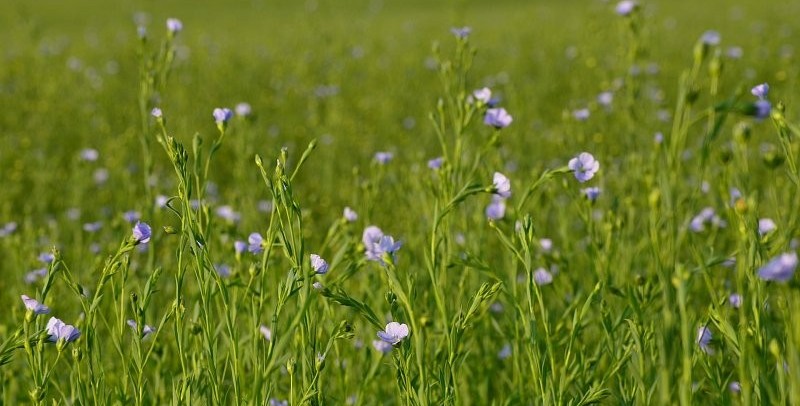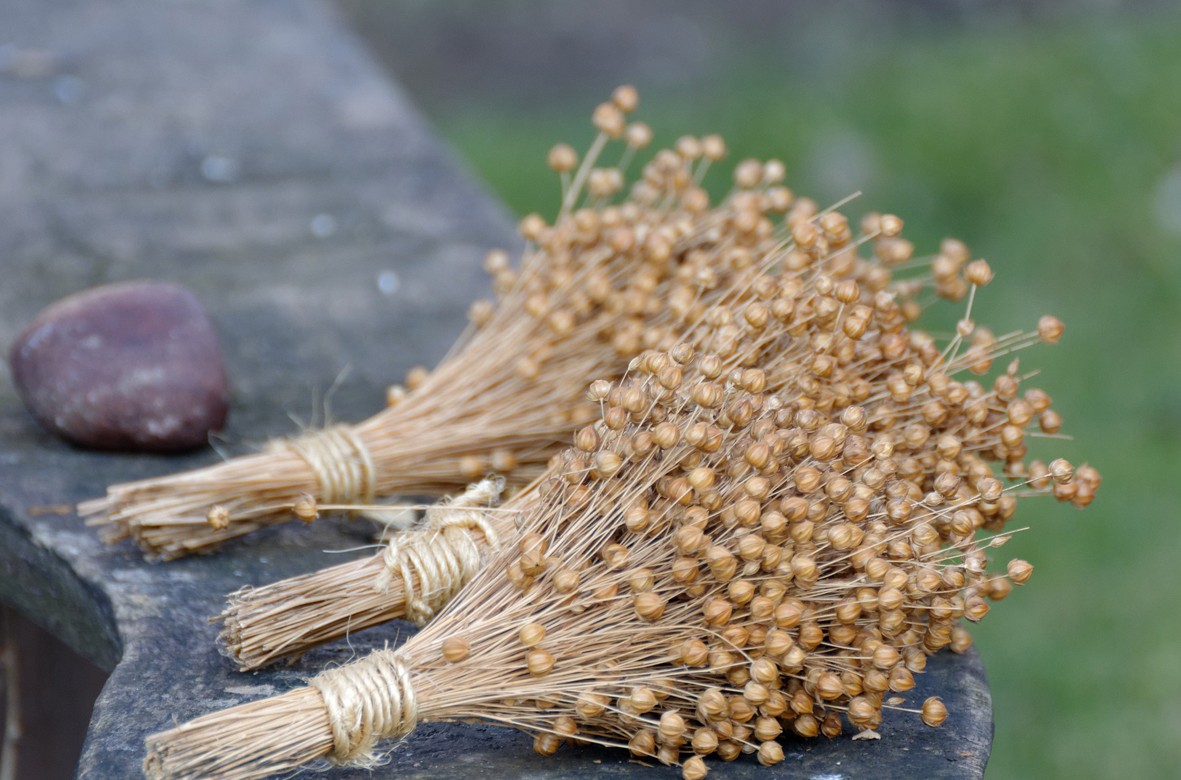Linen – a story of Love and Rejection

According to some sources, the history of this material dates back to ancient Egypt. Although it received many names during its fashion development, including the nickname ‘the material for poor people’, today it also gets into the collections of the most well-known and prestigious brands.
DID YOU KNOW…
That the French word ‘lingerie’ that we use today as a collective term for underwear, originally referred to just linen?
Technologically, the process of flax processing has hardly changed over the centuries. Pure flax fabrics are among the premium materials precisely because the high-quality naturally fibrous material does not get damaged by aggressive chemical processes. Not only the material in metrage, but also as clothing products made of flax create a cool, elegant impression: not cold and boring, but noble and still modern.
When it comes to comfort, not only on hot summer days, it will be your best friend. This beloved material, famous for its breathability and infinite durability, but also for its specific structure and, for some types of linen materials, also for its luxurious lustre, will become your favorite. We hope it will happen to you, just as it did to us. We definitely fell head over heels for it.
A tradition whose return after a period of sleep comes to back to life…
Almost the whole world is involved in the cultivation and processing of flax, even though the whole process is much more expensive for flax than for cotton. The outstanding places for its production include France, Belgium, the Netherlands, and especially Northern Ireland, which supplies virtually all of Europe. Linen production was also a key industry of the Czechs for many years. It was grown here (and is still grown to a limited extent) especially in the Bohemian-Moravian Highlands. Producers of this local flax, meaning of Czech origin, then process not only the raw material grown in our country, but also only imported flax.
Overall, the world is expected to increase its consumption of and demand for linen fabrics. Despite its long tradition (or just because of it), it is only today recognized around the world as a classic and still fashionable thread. Although it is not one of the most represented materials on the fashion market, linen itself is considered and perceived as a premium material.

What is it? …from a blue flower to a product that our children can inherit.
A flower with typical small pale blue flowers and a stem about 80 cm high, delicate, and at the same time one of the longest used natural ingredients, which - I would like to say - can handle anything. And modern too! Flax fiber material is obtained from the stalks of the Flax plant (Linum usitatissimum).
Let's remember the mole and his pants
Interestingly, flax production has not changed much since ancient times. We all know the fairy tale about Mole and his blue pants. Flax fibres are obtained from plant stems by a number of special technological processes. Just to give you an idea of that complicated process, here are a few steps you just have to go through before you can start weaving it:
• scrubbing off the leaves from the stems,
• soaking dissolves the pectose that connects the fibres to the stem wood,
• by breaking up and rubbing, the wood is crushed and the tow is separated from the long fibres,
• by bundling - the flax bundles are separated and at the same time the coarse and short fibres are removed,
• The flax fibres are wet-spun into yarns of various finenesses and quality.
The colour of flax fibre also plays an important role in evaluating the quality of the input flax material. Raw linen flax is darker, silver-gray; soaked flax is yellowish to fawn. The natural colour of flax is then often bleached, especially before dyeing or printing.
The traditional basis of flax processing remains, only now some final modifications of the fabric or finished flax product are used more. Flax can be softened, painted or bleached, provided with a waterproof layer, its creasability is reduced, etc.
Pure flax or mixed flax
Flax fabrics are those that are made of 100% flax or with at least 50% flax in a mixture with another material (cotton, silk, viscose and others). In its pure form, however, it is one of the finest materials on the clothing market.
Flax is one of the essential materials used all year round (not only in summer), it stands out on its own even against quality cotton. The combination of sand-colour linen pants and a white shirt is an ageless classic. Airy linen dresses shouldn’t be missing from any women's wardrobe. A linen skirt or elegant looser shorts combined with a silk top or a linen shirt with denim trousers… what more could you want? Simple, comfortable, yet stylish.
The benefits that only linen can offer
The popularity of flax lies in its benefits: features that no other material offers.
Especially in its breathability. The secret of this airiness is hidden in the fact that flax production requires about half the amount of fiber compared to cotton. In addition, it has a pleasant airy and cool touch.
Another advantage of flax is the ability to absorb moisture and at the same time release the absorbed moisture much faster, which dries much faster compared to other natural fabrics. It is therefore an ideal material for hot and humid weather at the same time.
Flax is also a hypoallergenic material that does not cause allergic reactions. Thanks to its smooth fibre structure (unlike other fibres - eg cotton, silk, wool, which have a scaly surface), it is also extremely resistant to pollution and dirt, because it does not absorb dust, resists mites, mold and also bacterial contamination. It is therefore an extremely suitable material for people suffering from various types of allergies, asthma, atopic eczema, psoriasis, etc.
It perfectly resists the negative effects of human sweat - no so-called ‘maps’ are created.
Flax has a very high resistance compared to other textile fibres. One of the most important properties of flax fibre is its strength (up to 30% stronger than cotton, up to 60% when wet!), It holds its shape perfectly even after many washes. Over time, it begins to shine pleasantly. The older it is, the softer it is and the more pleasant to the touch (cotton has rather the opposite tendency). Stronger and more valuable products can be made from solid fibre. Strength is partly influenced by conditions during the plant growth period, but also by the way it is processed. The fineness of the fibre is crucial for the fineness of the final yarn. The finer the fibre, the finer the yarn that can be spun and the finer the final linen product. Thus, the flax industry is not like other textile industries and even here it is necessary to choose a quality supplier, processor and producer. Only if they approach the material with respect and as a quality material for processing - will the yarn (fibre), yardage and final product be great and of high quality.
Linen products are almost age-free, are extremely resistant to mechanical damage, and the fabric structure is almost ‘thin’, despite the non-uniformity of the fibres and the rustic, more pronounced surface typical of fine and coarse linen yarns alike.
|
• strong and durable • breathable, perfectly removes heat and moisture • hypoallergenic • provides protection against UV radiation • holds its shape well • less water and chemicals are used in its processing (more environmentally friendly than cotton) • does not attract and absorb dust (does not need to be washed as often as cotton) |
But nothing’s perfect…
Of course, it does have certain disadvantages. The inelasticity and, from a certain point of view, the ‘hardness’ of the material itself may not be a problem for many people, but the biggest disadvantage of flax is its significant creasability.
|
• high creasability, which is not always such a disadvantage; • Coagulation must be taken into account during washing, if the manufacturer does not state that it is sanforized, ie pre-coagulated flax. Even then, slight precipitation at high temperatures is characteristic of flax; • Easily stained from contact with other materials. |
Take good care of what we care about
Linen just likes to breathe, so store linen clothes in a loose closet and sometimes you can ventilate them in the fresh air.
Linen products tolerate classic washing in a washing machine. During the first wash, however, it is necessary to take into account a certain degree of coagulation - about 3-7%, this is a specific property of flax fibre, which can be mitigated by strictly following the recommended rules.
The smooth structure of the flax fibre makes it much easier to release dirt during washing. Therefore, linen fabric does not require high washing temperatures (although it can withstand them) or aggressive detergents. Flax fibre shows high resistance to alkalis, acids and their solutions. So, ideally per 40 ° C. Some white flax can withstand a temperature of 60 ° C. Flax fibres are more prone to breakage, so they should not be squeezed. Maintain the same water temperature when washing and rinsing. When washing linen, use a mild detergent and wash cycle for delicate materials. Avoid fabric softeners and bleaches. You can dry linen clothes in the dryer for a short time for a gentle program.
|
• we recommend washing at 40 ºC and with the gentle program option, some products can be washed at 60 ºC. It is possible to boil it (the fibre will not be damaged), but it is necessary to take into account the greater shrinkage of the material (5-10%). • when washing, use ecological detergents, preferably based on pure / simple soap. • only tends to catch the fibres of other fabrics (cotton, wool, etc.), so it is advisable to wash linen products separately • Do not run or use chemical cleaners • spin-dry at lower speeds (you will reduce especially its natural creasing). |
Just sprinkle a little water before ironing, it will be easier for you. Generally, they are only ironed at a higher temperature. You can iron light flax on both sides, dark inside out so that white maps do not form. When washing with other materials, it tends to absorb fine hairs, and thus lose its shine and color. Therefore, put linen things in a linen ‘laundry bag’ or linen pillowcase.
|
• moisten the fabric before ironing or pressing; • when ironing, use the highest ironing temperatures (usually indicated on the control: len, lin, linen, leinen, etc.) - linen has an extraordinary ability to withstand high temperatures, which also better balances the crumpled fibres. |
Výše uvedené zásady mohou ještě navýšit už tak dlouhou životnost lněného materiálu, která je opravdu mimořádná. Navíc má i environmentální hodnotu – z hlediska nízké energetické náročnosti a ekologické zátěže. Příjemný může být jistě i ekonomický efekt (dlouhá trvanlivost materiálu, nízké teploty při praní, kratší prací cyklus).
Přestože žijeme v období modernizace snad úplně všeho okolo nás, v době, kdy syntetická, neprodyšná, ale nemačkavá a téměř bezúdržbová vlákna bereme jako přirozenou součást, touží člověk po doteku přírody, po něčem neumělém, částečně nedokonalém, po něčem, co není naprogramované a přesné.
BUSHMAN PŘEDSTAVUJE KOLEKCI OBLEČENÍ Z BAVLNY A LNU:
-
rustikální vzhled látky v kombinaci bavlny se lnem
-
osvědčená letní klasika
-
savost bavlny a příjemný pocit při nošení
-
chladivý dojem a zrnitější struktura lnu
BUSHMAN CALVARY SHORTS
84 % cotton, 16 % linen
Linen with cotton in the final crepe finish
BUSHMAN SARGEANT
55 % cotton, 45 % linen
Our timeless safari blazer












